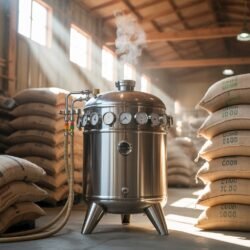Anaerobic fermentation is a game-changer for specialty coffee, unlocking wild flavors and unique profiles that set your coffee apart. But to get the best results, you can’t just throw your cherries in a tank and hope for the best. Here are the four things you absolutely need to keep an eye on to ensure your anaerobic coffee fermentation is a success.
1. Temperature: The Heartbeat of Fermentation
Temperature is like the conductor of your fermentation orchestra. If it’s too cold, your fermentation will crawl along, and you might not develop the flavors you’re after. If it’s too hot, you risk encouraging unwanted microbes that can spoil your batch. Most producers aim for a sweet spot between 23–28°C (73–82°F), but consistency is just as important as hitting the right number. Sudden swings can throw off the whole process, so keep a close watch and adjust as needed.
2. pH: The Flavor Barometer
pH is your best friend when it comes to flavor development. As fermentation progresses, the pH drops—usually from around 5.5–6.0 down to 3.5–4.0—thanks to the acids produced by your friendly microbes. This acidity is what gives anaerobic coffees their bright, vibrant character. But if the pH drops too far or too fast, you might end up with a coffee that’s harsh or overly sour. Regular pH checks help you stay on track and avoid any unpleasant surprises.
3. Fermentation Time: The Art of Patience
Timing is everything. Ferment too short, and your coffee might taste green or underdeveloped. Ferment too long, and you risk off-flavors or even spoilage. The ideal fermentation time can vary depending on your method and the flavors you want to highlight, but it’s usually somewhere between 24 and 96 hours. The trick is to sample regularly and trust your senses—when the flavors start to pop and the mucilage breaks down just right, that’s your cue to move on.
4. Pressure and Gas Release: Keeping Things Safe and Sound
Anaerobic fermentation is a living, breathing process—literally. As microbes work their magic, they produce CO₂, which builds up pressure inside your sealed tank. Too much pressure can be dangerous, so it’s essential to use one-way valves to let gas escape safely. Watching the bubbles and listening for the hiss of escaping gas can also give you clues about how your fermentation is progressing. Keeping pressure under control ensures your coffee—and your equipment—stay safe.
The Bottom Line
Anaerobic coffee fermentation is part science, part art. By keeping a close eye on temperature, pH, fermentation time, and pressure, you can guide your coffee to its full potential and create something truly special. So grab your thermometer, pH meter, and stopwatch—your next great cup is just a batch away!


